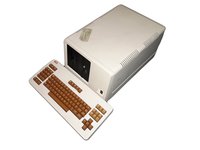Logica VTS 2200
| Home > Browse Our Collection > Computers > Logica > Logica VTS 2200 |
|
Notes from Jim Gartside & Gren Gale, the system had the development name Project Whirlwind, the software team numbered around 25. Running around an 8080 or 8086 processor, with 64K partitioned RAM. The machine was a word processor, and cost around 5,000, initially very successful, with customers such as Shell as big customers. It was voted in a Marplan poll as ICL’s most popular product with its customers and won for Logica the Queen’s Award to Industry for Technological Innovation in 1983. These were also re-badged by British Telecom (as the M3300) and Nexos. They could be networked on a Cambridge Ring and were also used internally as development workstations running an Intel development system (8086 assembler and PL/M-86). ICL also produced a badged version of the machine, the ICL 8801, which very soon increased competition from the likes of Amstrad with their much cheaper machines, changed the market landscape and Logica VTS closed in 1986. Has two 5.25 Disk Drives, and keyboard with some unique commands such as 'close up'. The follow up hardware was the Vitesse, which was a full PC, Kennet was the hardware and Avon was the operating system, which was to be Unix based, after initially being based on CP/M and DOS.;. Notes provided by the donor of this object: I have a 1980's vintage Logica VTS2200 (aka Kennet, also branded and sold by ICL)...The system was an early desktop computer for office automation which nearly bankrupted Logica when the IBM PC took off. The Kennet systems were still widely used for office automation at Logica when I joined in late 1988. In those days there was still a "typing pool" too, to which you could post manuscripts and a floppy. There was an author, I believe Beryl Bainbridge, who used one of these (not this one) for writing her books. She shunned the PC because the Kennet did what she wanted and she knew how to use it. Manufacturer: Logica Comment on This Page Other Systems Related To Logica VTS 2200 :
This exhibit has a reference ID of CH47664. Please quote this reference ID in any communication with the Centre for Computing History. |
|











